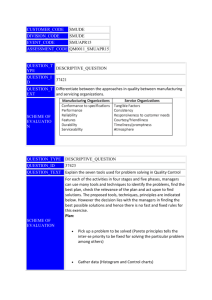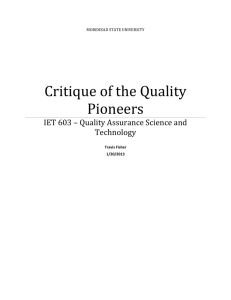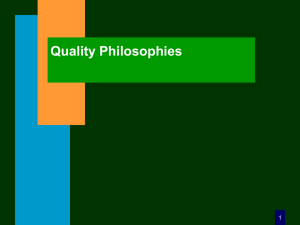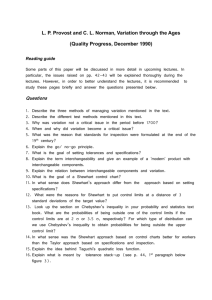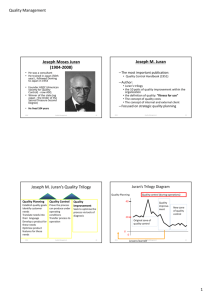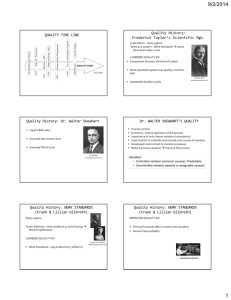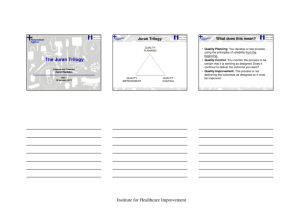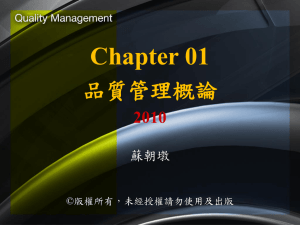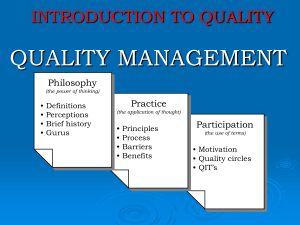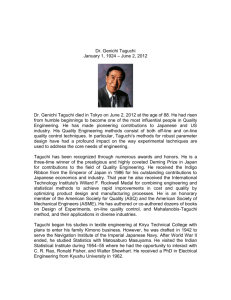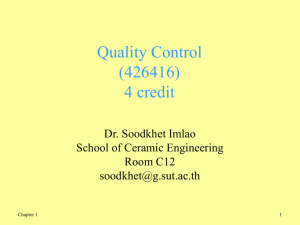File
advertisement
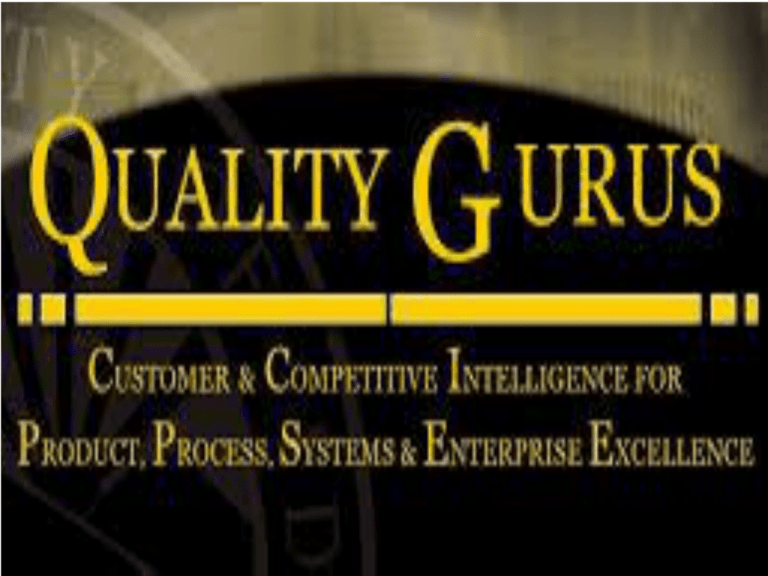
DR. KAORU ISHIKAWA`S BIOGRAPHY Born: July 13, 1915 Died: April 16, 1989 1939- Graduated from the Department of Applied Chemistry, University of Tokyo Employed in coal liquefaction and obtained experience in design, construction, operations, research. 1939 - 1941 - Naval Technical Officer In charge of 600 workers to construct a factory. - this experience he says was invaluable to QC activities later on. 1941-1947 Ishikawa worked at the Nissan Liquid Fuel Company 1947 - Researcher, University of Tokyo, began studying statistical methods 1949- jointed JUSE QC research group and became an instructor. CONTRIBUTIONS TO QUALITY • • • • • User Friendly Quality Control Fishbone Cause and Effect Diagram - Ishikawa diagram Implementation of Quality Circles Emphasized the Internal customer Shared Vision ACHIEVEMENT • 1952- Director of the Chemical Society of Japan • 1969- Member of ISO, Japan • 1970- Commenced conducting quality control training seminars. • Consultant to Ford Motor Company, Bridgestone Co. • Ltd, Komatsu Manufacturing, Ltd., IBM Japan, • American Society for Quality Control and thousands of other companies. • 1977 -Chairman of ISO, Japan • 1981- Executive Member of ISO • 1981- Published What is Total Quality Control? The Japanese Way, first edition. BACKGROUND OF JOSEPH M. JURAN • December, 1904- Joseph M. Juran was born in Romania, Barisilia • 5 years old-his father left Romania and came to the United States for a better life for his family • After they came to U.S, they still remained in poverty • By using his intelligence and dedication Juran changed himself from a poor Romanian immigrant into a world renowned quality control expert. ACHIEVEMENT 1937 - the Chief of Industrial Engineering at Western Electric’s home office in New York. 1945 - he took the position of Chairman of the Department of Administrative Engineering at New York University at 40 years old. 1928 - he wrote a pamphlet entitled “Statistical Methods Applied to Manufacturing Problems”. This pamphlet has since become the basis for the well-knows Statistical Quality Control Handbook, which is still published today. Nearly thirty years after Juran visited Japan, Emperor Hirohito recognized Juran’s contribution to the development of Japan’s quality control and the facilitation of a U.S. and Japanese friendship. Juran was awarded the highest award that can be given to a non- Japanese person, the Order of the Sacred Treasure. CONTRIBUTIONS • 1937-he developed “Pareto principle,” many managers use the principle to help separate the “vital few” from the “useful many” in their activities. The application makes it one of the most useful concepts. • Dr. Juran wrote the first standard reference work on quality management, the Quality Control Handbook. This handbook is the reference for most quality and performance improvement change agents since it provides important how-to information specifically for improving an organization’s performance by improving the quality of its goods and services. • In 1964 - His classic book, Managerial Breakthrough, first published presented a more general theory of quality management. It was the first book to explain a step-by-step sequence for brilliant improvement. This process has grown to Lean and Six Sigma. CONTRIBUTIONS (cont.) • 1986- The Juran Trilogy was established. The trilogy was accepted worldwide as the basis for quality management. His trilogy defined three management processes required by all organizations to improve. Quality control, quality improvement, and quality planning • Dr . Juran was the first figure combines the human aspects of quality management , referred to as Total Quality Management in which man is the most important aspect for determining quality standards . Provide For Theory For Management To Improve Quality, Productivity And Competitive Position Born : • October 14, 1900 , at Sioux City, Iowa Died : • December 20, 1993 (aged 93) at Washington Married : • In 1922 and 1932 BACKGROUND • Deming received a BSc in electrical engineering from the University of Wyoming at Laramie (1921), an MS from the University of Colorado (1925), and a PhD from Yale University (1928). Both graduate degrees were in mathematics and physics. • W. Edwards Deming was a statistician and business consultant whose methods help hasten Japan's recovery after WWII and beyond. • He is best known for promoting his management method called 14 Points which is based and derived on a system of thought called the System of Profound Knowledge CONTRIBUTION • • • • 7 deadly disease Deming Cycle (PDCA) System of profound knowledge 14 point 1. 2. 3. 4. 5. 6. 7. 8. 9. 10. 11. 12. 13. 14. Create a constant purpose toward improvement Adopt the new philosophy Stop depending on inspections Use a single supplier for any one item Improve constantly and forever Use training on the job Implement leadership Eliminate fear Break down barriers between department Get rid of unclear slogan Eliminate management by objectives Remove barriers to pride of workmanship Implement education and self-improvement Make “transformation” everyone’s job ACHIEVEMENT • • • • • • • • • Doctorate in mathematical physics from Yale University in 1928 Degrees LL.D. and Sc.D. honoris causa Madeleine of Jesus Award from Rivier College Shewhart Medal from the American Society for Quality Control in 1956 and the Samuel S The Emperor of Japan award in 1960 Wilks Award from the American Statistical Association in 1983 National Medal of Technology to Dr. Deming in 1987 from President Reagan Distinguished Career in Science award from the National Academy of Sciences in 1988 The author of several books and about 200 papers. His books, "Out of the Crisis" (MIT/CAES, 1986) and "The New Economics" (MIT/CAES, 1994) • Walter Andrew Shewhart • American physicist, engineer and statistician • Father of statistical quality control and also related to the Shewhart cycle. • Born in New Canton, Illinois to Anton and Esta Barney Shewhart • Study at University of Illinois being awarded his doctorate in physics from the University of California, Berkeley in 1917 • Married Edna Elizabeth Hart, daughter of William Nathaniel and Isabelle "Ibie" Lippencott Hart on August 4, 1914 in Pike County, Illinois. Shewhart joined the Western Electric Company to assist their engineers in improving the quality of telephone hardware. Shewhart identified two categories of variation which he called “assignable‐cause” and “chance‐cause” variation. PLAN DO ACT STUDY What is Statistical Process Control (SPC)? • Quality data in the form of Product or Process measurements are obtained in realtime during manufacturing. This data is then plotted on a graph with predetermined control limits. • An industry-standard methodology for measuring and controlling quality during the manufacturing process •Control limits are determined by the capability of the process, whereas specification limits are determined by the client's needs. PLAN DO ACT STUDY Identify what can be improved and what change is needed Implement the design change Measure and analyse the process or outcome If the results are not as hoped for WALTER A. SHEWHART • Founding member, fellow and president of the Institute of Mathematical Statistics • Founding member, first honorary member and first Shewhart Medallists of the American Society for Quality • Fellow and President of the American Statistical Association • Fellow of the International Statistical Institute • Honorary fellow of the Royal Statistical Society • Holley medal of the American Society of Mechanical Engineers • Honorary Doctor of Science, Indian Statistical Institute, Calcutta GENICHI TAGUCHI Born on January 1, 1924 Tokamachi, Japan. Initially studied textile engineering at Kiryu Technical College In 1942, he was drafted into the Astronomical Department of the Navigation Institute of the Imperial Japanese Navy. In 1950, he joined the Electrical Communications Laboratory (ECL) of the Nippon Telegraph and Telephone Corporation. Since 1982, Genichi Taguchi has been an advisor to the Japanese Standards Institute and executive director of the American Supplier Institute, an international consulting organization. BACKGROUND • Taguchi defines Quality as “the loss imparted by the product to society from the time the product is shipped” • Taguchi spent his twelve years there in developing methods for enhancing quality and reliability. • Father of “Taguchi method” and “Robust Engineering”. • He also applied his quality improvement knowledge at Morinaga Pharmaceutical and even worked for a candy maker, Morinaga Sieka, to reduce the melting properties of caramel at room temperature • Conventional industrial engineering considers quality costs as the cost of rework or scrap of items manufactured outside specification. • Taguchi considered such private costs to the manufacturers as short-term costs, and introduced a new approach of understanding costs to society owing to non-conformance with specifications. • Taguchi focuses mostly on off-line cost quality control. Means improving quality and reducing total cost in design stage. CONTRIBUTIONS Taguchi has made a very influential contribution to industrial statistics. Key elements of his quality philosophy include the following: Taguchi loss function, used to measure financial loss to society resulting from poor quality; The philosophy of off-line quality control, designing products and processes so that they are insensitive ("robust") to parameters outside the design engineer's control; and Innovations in the statistical design of experiments, notably the use of an outer array for factors that are uncontrollable in real life, but are systematically varied in the experiment. ACHIEVEMENTS • 1986 - Willard F. Rockwell Medal of the International Technology Institute • 1989 - Indigo Ribbon from the Emperor of Japan • 1990 - Honoured as a Quality Guru by the British Department of Trade and Industry • 1995 - Honorary member of the Japanese Society of Quality Control • 1997 - Automotive Hall of Fame Inductee • 1998 - Honorary member of the American Society for Quality[4] • 1998 - Honorary member of the American Society of Mechanical Engineers • 1999 - Honorary president of the Robust Quality Engineering Society (Japan)

